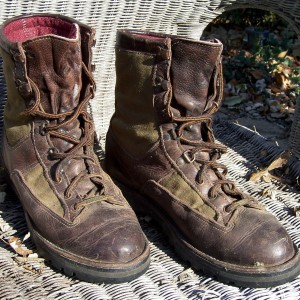
ARMY/NAVY PRODUCT REVIEWS (Summer 2013)
By: Jim Lavalley
Yugoslavian Mess Kit
 One of the more interesting aspects about reviewing military surplus products is being able to compare foreign military items to their American counterparts. It’s amazing to see the differences between materials and engineering used by various countries around the world to equip their fighting forces. While the U.S. produces some of the most functional and efficient gear in the world, it’s obvious that we don’t have a monopoly on ingenuity. For me, the best proof of that observation is on those occasions when I get my hands on an item that makes me wish I had been issued it while I was in uniform, instead of its domestic alternative. Case in point: the Yugoslavian Mess Kit.
One of the more interesting aspects about reviewing military surplus products is being able to compare foreign military items to their American counterparts. It’s amazing to see the differences between materials and engineering used by various countries around the world to equip their fighting forces. While the U.S. produces some of the most functional and efficient gear in the world, it’s obvious that we don’t have a monopoly on ingenuity. For me, the best proof of that observation is on those occasions when I get my hands on an item that makes me wish I had been issued it while I was in uniform, instead of its domestic alternative. Case in point: the Yugoslavian Mess Kit.
This kit is an eight-piece affair. The entire kit consists of the following:
1. Canvas pouch with cover
2. Aluminum pot
3. Plastic bowl
4. Plastic canteen
5. Plastic cup
6. Spoon
7. Fork
8. Knife/Can opener/Bottle opener.
The five containers (items 1-5) are OD green; the three-piece interlocking flatware set (items 6-8) is stainless steel. When assembled, the entire kit weighs 1 pound, 11 ounces, and forms a rectangular box inside its canvas pouch. The pouch has two three-inch loops sewn into the back to affix a wide belt, such as a pistol belt. The attached cover secures over the top like most ammunition pouches and uses a heavy duty snap fastener to secure it closed. Utensils fit into a retaining pocket sewn inside the pouch. The dimensions of the kit within its pouch are 7 ½” tall x 5” wide x 3 ¼” deep. The pouch itself is a light to medium weight canvas which is durable, but not indestructible. However, the pouch could also be used to hold any item or group of objects fitting within the previous dimensions.
In true Eastern European fashion, the containers in the kit (which are all rectangular) are nested together like a collection of Russian Dolls. The openings in the aluminum pot and the plastic bowl fit together to form a box. The hinged handle of the pot has a 90-degree bend so it can double as a latch to secure the two containers together. Once the handle is unlatched, it takes a bit of jiggling to separate them from the friction holding them together. They can also be pried apart using the knife, but some care must be taken to avoid damaging each part. Once separated, there is a canteen inside featuring a cup covering the cap and using another friction connection.
The aluminum pot has no markings and no Teflon coating inside. Each plastic part is stamped with the following, “NE DRŽATI NA VATRI”. A quick look online for the translation told me this is Croatian for “DO NOT PUT IN FIRE”. So, while the plastic parts are durable, they’re obviously not fireproof. The plastic bowl itself features a molded plastic slot. It took me a bit of experimenting to discover that the slot fits the bend in the handle of the aluminum pot. This stabilizes both containers and helps keep either one from tipping over – very clever. It may also serve as a potholder to pick up the hot pot from a heat source, but one should be very careful doing it that way.
The four solid containers have the following capacities, and since this kit is European, I figured out correctly that the measurements are metric:
1. Canteen – 1 liter (just over a quart)
2. Aluminum pot – 1 liter
3. Plastic bowl – 0.8 liter / 800 ml
4. Plastic cup – 0.2 liter / 200 ml.
Finally, the spoon, fork, and knife fit together in a retaining sleeve that is the hollow cavity of the knife handle. The spoon and fork are unremarkable, other than the spoon is generously sized, somewhere between a regular spoon and a serving spoon. The knife is multifunctional and quite useful. Besides acting as the flatware organizer, it features a serrated front 1/3 of the blade and a sharp smooth edge along the next 2/3. Below the blade is a bottle opener, and on the opposite side of the hollow handle is a can opener that can apply much more leverage than the venerable American C-Ration keychain can opener, more commonly known as the “P-38”.
Overall, this particular kit, and others like it, has the utility that makes it a sure-fire seller to outdoor sports enthusiasts and customers of survival gear. It’s sturdy, compact, and simple to use. It can easily be sold on its own, but I feel that surplus equipment vendors would also benefit the value of this item by combining it with camping gear and a field food guide particular to their region. Whatever the option, mess kits like this Yugoslavian version are sure to draw revenue when marketed correctly.
Swiss Nylon Waterproof Bag

Throughout my Army career various equipment I was issued changed over the years. However, one thing I recall that remained constant was the green nylon waterproof bag. Used primarily to store a sleeping bag for the field, it was also often used as animpromptu laundry bag, or a place to keep a dry set of clothes in a wet environment. A simple affair, it was just a rubberized nylon bag with a long string to tie the top of the bag closed. It never occurred to me that it could be improved.
Leave it to the Swiss to prove me wrong. Their version of the waterproof bag is cylindrical when it’s filled. Laid flat and empty it is 20 inches wide by around 2 feet tall. It’s similar in size, and it has a more olive drab color than its greener U.S. counterpart. Both U.S. and Swiss bags feature a flap inside that keeps moisture from entering through the tied top of the bag. There are two improvements the Swiss features, though. Their bag has a cinch tie within the top seam to secure it closed. The Swiss bag also has a name tape (ID) frame sewn to the outside of the bag. Both are great improvements.
For camping or outdoor recreation where you or your belongings can expect to get wet, nothing beats a military waterproof bag as protection against the elements. In an emergency, a waterproof bag can even be used as a flotation device. They’re inexpensive, so there is no reason why any outdoor enthusiast shouldn’t buy several of them.
Individual First Aid Kit (IFAK) Insert 
For my first four years in the Army, I was a combat medic in a tank battalion. This was the mid-1980s, and for many decades it had the medic’s job to handle nearly all of the battlefield wounds and training accidents. Armed with bags of medical supplies and bandages, medics have been repeatedly distinguishing themselves by selfless service to their fellow military members. Until recently, though, the average warfighter was only issued a field dressing, a standard bandage that had been in use since World War II. The idea was for the wounded to be initially treated by their fellow troops and stabilized until better-trained and -supplied medical help arrived. Often, field dressings were augmented by vehicle-mounted first aid kits, but it wasn’t always practical to get to these supplies in an emergency.
This philosophy was employed for most of the last century. During the Gulf Conflict, the Armed Services realized that while medics and corpsman had always done phenomenal work, it just wasn’t possible to have a medical professional in all the places they needed to be. People were still dying or suffering debilitating wounds through a lack of sufficient medical treatment. So, combat first-aid training for selected members of each small unit became a requirement. Initially, however, there was no standard for the medical supplies they carried. Combat aid persons were often issued abbreviated versions of medic’s aid bags, and the contents were dictated by local policy. Finally, in 2005, the Army came up with the Individual First Aid Kit, or IFAK. The Marines had been using a similar configuration for years.
The concept of the IFAK was simple. Give the combat aid provider the supplies to stop most bleeding and keep their patients breathing. The resulting kit was designed to fit entirely within a MOLLE PALS pouch, more often known as an ammunition pouch. The IFAK consists of the aforementioned ammo pouch, a nylon insert, a tourniquet, a nasal pharyngeal airway (J-Tube), surgical gloves, a trauma dressing, a roll of surgical tape, and compressed gauze.
The IFAK insert I am reviewing is one component of that kit. It is a “T” shaped section of heavy, OD green nylon with a border sewn around the outside. Hook-and-loop (Velcro®) strips are sewn to the fabric so that the insert can be folded into a wallet containing supplies. Three elastic bands are sewn to the fabric to retain and organize those supplies. Finally three grommets are riveted into the fabric, one for securing the insert with a cord to the pouch and two on either side of a short strip of elastic designed to secure a roll of surgical tape. This particular elastic band expands to hold a cylinder about 2” wide with a 2 ½” diameter. Another, similar elastic band is sewn on the reverse. It can expand to about 3” in diameter and is on the outside of the insert when folded. Finally, one long strip of elastic is sewn in several places to accompany six various-sized items. Three compartments are small enough for pens, scissors, penlights or similar items. One 3” section held my personal wallet comfortably, and the remaining two spots are 2 ¼” and 1 ¾” respectively. Without contents, the insert folds into a 5 ¼” x 7” wallet, but with supplies it can expand to accommodate a fair amount inside. Finally, if the insert is used with a pouch, individual items should be no more than 6-7” long.
The IFAK insert is a flexible item organizer. It is best employed as a means of grouping oddly shaped tools and/or supplies that belong to a single category. Some examples that I thought of are electrical tools, large weapon cleaning kits, hobbyist tools, small camping tools, eating utensils, fishing/hunting accessories, and of course, first aid/medical tools. Although the insert could be sold as is, I believe the best opportunity would be to use it with another container (such as the MOLLE PALS) and other surplus items to fashion individual kits for sale to customers. One final thought: it could be part of a customer “Design Your Own Kit” display, featuring bulk surplus supply items.
When I get a couple of surplus products that are part of the same category, I try to review them at the same time. Such is the case with the simple little device that pairs well with the Yugoslavian Mess Kit I also reviewed in this issue. The French Canteen Cup Stove isn’t a stove in the modern sense, though. It is a nonflammable support for a container over heat; it’s a burner without the fire source.
The stove itself fits in my hand. It’s made of three parts: a fuel and combustion tray made of highly efficient, heat-transferring aluminum and two steel wires that fold up to support a cup or small pot over a flame. For example, the aluminum pot in the Yugoslavian mess kit fits perfectly over the support wires of the stove. The wires provide aeration space like any burner support on a gas or propane stove. The device is designed to fit over the bottom of a French canteen cup, which in turn fits over the bottom of a metal French canteen. The stove is oval-shaped; it looks like two boot heel caps joined face two face. It’s 3” wide and 4 5/8” long at the longest points. Two aeration slots are cut into each end of the combustion tray. Four small holes act as locking points for the steel wire supports when they are folded upwards. Three dents have been formed in the bottom of the tray to act as support feet on flat surfaces.
Propane and liquid fuel camp stoves are pretty ubiquitous nowadays. They vary in size from small, one-burner contraptions to full-sized kitchens that make even Iron Chefs envious. So, why would anyone want to bother with such an apparently trivial object? I can think of a few answers to that question. First, this stove is a useful backup to more complete systems. This device (and others like it) is a perfect way to conserve fuel in a primary gas stove. When all someone wants is a cup of hot liquid or small canned meal, there’s no point in wasting gas, especially when a campfire is already burning. Taken a step further, propane and liquid fuel stoves are of little use in survival situations after the gas runs out. It’s smart to cover the bases when expecting to spend time in the wilderness. Second, this stove is an alternative for those who take environmental impact seriously, or for those who enjoy the challenge of truly roughing it. Finally, this device is designed to save weight and space. As such, it’s particularly handy when energy conservation is paramount, such as for treks out from a base camp for hunting, fishing, kayaking, biking, and exploring.
It’s my opinion that these kind of tools are best marketed when paired with the equipment they were issued with. However, since it’s sometimes the case that surplus accessories are available in odd lots, a little creativity might be needed to generate revenue. Luckily, this particular stove is versatile enough to work with all sorts of food preparation surplus items. It can even heat MRE and camping food packets. While it may only be an exact fit over the actual French canteen, it’s small enough to carry around on its own, in just about any type of backpack, container, or vehicle storage. This kind of inexpensive utility makes it a good bargain for any type of outdoor enthusiast.




